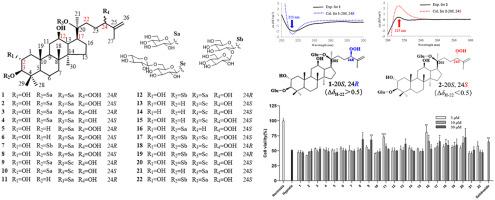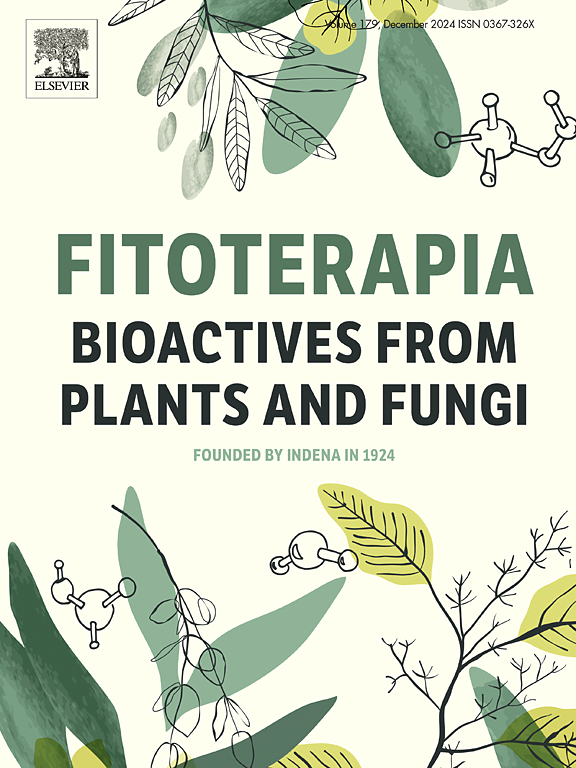绞股蓝达玛烷型皂苷新的C-24外旋体及其绝对构型
IF 2.6
3区 医学
Q3 CHEMISTRY, MEDICINAL
引用次数: 0
摘要
从绞股蓝中分离到17个新的达玛烷型皂苷,其中绞股蓝皂苷FJ1 ~ FJ17(1-17)和5个已知化合物(18-22),包括9对C-24外显体。通过全面的一维和二维核磁共振波谱分析和HR-ESI-MS数据确定了它们的结构。通过电子圆二色性(ECD)分析确定了5对C-24表映体化合物(1-10)的绝对构型。有趣的是,详细的光谱分析表明,外显子的C-24构型与H-22的化学位移差值(ΔδH-22 > 0.5, 24R; ΔδH-22 < 0.5, 24S)有关,这为快速确定达马烷型皂苷C-24外显子的C-24构型提供了一种简单方便的方法。该规则使化合物11-22的C-24构型快速分配成为可能。缺氧条件下PC12细胞的抗缺氧活性评价表明,化合物8、9、11、13和16-20能有效保护PC12细胞免受缺氧损伤。本文章由计算机程序翻译,如有差异,请以英文原文为准。

New C-24 epimers of dammarane-type saponins from Gynostemma pentaphyllum and their absolute configurations
Seventeen new dammarane-type saponins, gypenosides FJ1 − FJ17 (1–17), and five known compounds (18–22) including nine pairs of C-24 epimers were isolated from Gynostemma pentaphyllum. Their structures were determined through comprehensive 1D and 2D NMR spectroscopic analyses and HR-ESI-MS data. The absolute configurations of five pairs of C-24 epimer compounds (1–10) were assigned via electronic circular dichroism (ECD) analyses. Interestingly, a detailed spectroscopic analysis indicated that the C-24 configuration of epimers was associated with the chemical shift difference value of H-22 (ΔδH-22 > 0.5, 24R; ΔδH-22 < 0.5, 24S), leading to a simple and convenient method for the rapid assignment of C-24 configuration in C-24 epimers of dammarane-type saponins. This rule enabled rapid C-24 configuration assignment for compounds 11–22. Anti-hypoxic activity evaluation in PC12 cells under hypoxia demonstrated that compounds 8, 9, 11, 13 and 16–20 effectively protected PC12 cells from hypoxia-induced injury.
求助全文
通过发布文献求助,成功后即可免费获取论文全文。
去求助
来源期刊

Fitoterapia
医学-药学
CiteScore
5.80
自引率
2.90%
发文量
198
审稿时长
1.5 months
期刊介绍:
Fitoterapia is a Journal dedicated to medicinal plants and to bioactive natural products of plant origin. It publishes original contributions in seven major areas:
1. Characterization of active ingredients of medicinal plants
2. Development of standardization method for bioactive plant extracts and natural products
3. Identification of bioactivity in plant extracts
4. Identification of targets and mechanism of activity of plant extracts
5. Production and genomic characterization of medicinal plants biomass
6. Chemistry and biochemistry of bioactive natural products of plant origin
7. Critical reviews of the historical, clinical and legal status of medicinal plants, and accounts on topical issues.
 求助内容:
求助内容: 应助结果提醒方式:
应助结果提醒方式:


